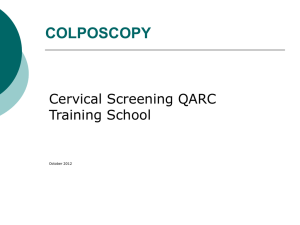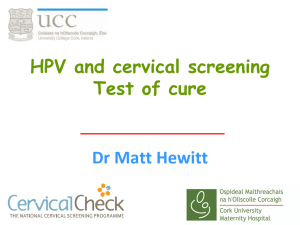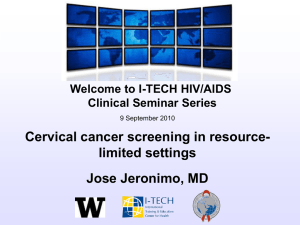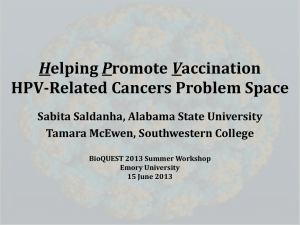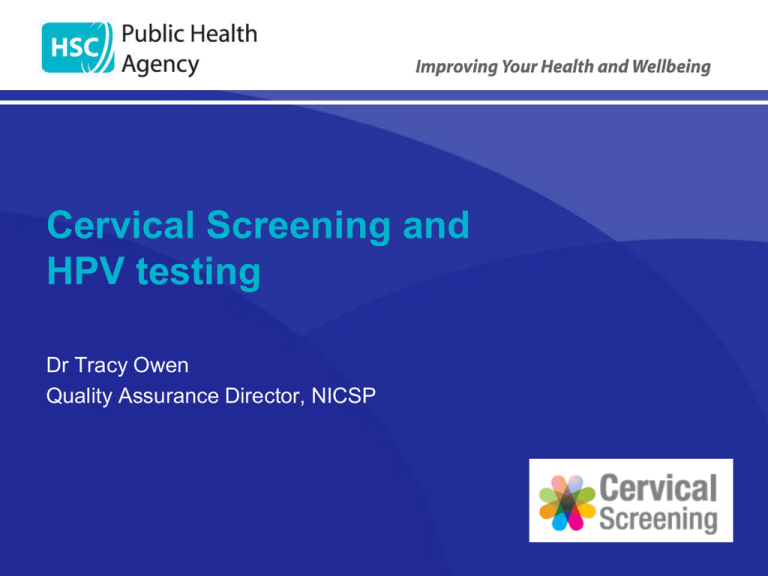
Cervical Screening and
HPV testing
Dr Tracy Owen
Quality Assurance Director, NICSP
Aim of screening
•
To reduce mortality and morbidity associated with cervical cancer
•
by identifying and treating pre-cancerous changes
•
Screening can prevent 70% of cervical cancers
•
Liquid based cytology – introduced 2007/08
•
? Role of HPV testing in screening pathway - HPV detected in 99.7%
of cervical cancers
Coverage rates by Trust
NI coverage = 77.32% (2010/11)
Coverage = % of eligible women with a screening result in last 5 years
5 year coverage by age group
80
% coverage
75
2008-09
70
2009-10
2010-11
65
60
25-29 30-34 35-39 40-44 45-49 50-54 55-59 60-64
Is there anything else that you can do to
improve informed choice in your practice?
Reminder - policy change
From Jan 2011
Age
Screening interval
25 – 49 yrs
3 years
50 – 64 yrs
5 years
Evidence based, endorsed by UK National Screening Committee,
in line with WHO recommendations
What do we know about HPV?
•
>100 types – only small number cause cervical cancer (HR-HPV)
•
Transient infection very common - 8 in 10 people infected in lifetime
•
Prevalence decreases with age (Manchester study)
• 40% of 20-24yr olds with HR HPV, 5% of 60-64 yr olds
•
Can’t be treated but can clear on its own
•
Infection persists in 20-30% of women
HPV – a complicated issue
•
Women or their partners may have HPV for many years without
knowing it
•
99% of cervical cancers associated with persistent infection with high
risk types of HPV (70% linked to HPV 16 or 18).
•
Transmitted by close skin-to-skin contact
•
Condoms help but don’t provide full protection
HPV testing and screening
•
HR-HPV testing at two points in screening pathway - Triage and Test
of Cure
•
Improved management of ‘low grade’ abnormalities
•
Introduced for smears taken from Monday 28 January 2013
•
Applies to women in screening age range (25-64 yrs)
•
HPV test is carried out on the same sample
HPV triage
•
15-20% of women with borderline/mild changes have a significant
abnormality that needs treatment
•
HR-HPV testing is effective in identifying which women may need
treatment
•
All borderline/mild samples are tested for HR-HPV (Triage)
•
HR-HPV positive are referred immediately to colposcopy
•
HR-HPV negative can be safely returned to routine recall
Triage
pathway
Borderline/Mild
Dyskaryosis
HR-HPV test
HR-HPV Negative
HR-HPV Positive
Routine recall
Colposcopy
referral
Benefits of triage
•
Reduces the need for multiple repeat tests – reduces anxiety & cost
•
Colposcopy is focused on the women who are more likely to have
significant disease
•
Women get to colposcopy sooner
•
Negative predictive value of HR-HPV test is reported between 93.8
and 99.7%
•
?reduced DNA rate at colposcopy
STANDARD PROTOCOL
HPV TRIAGE PROTOCOL
Routine screen
Routine screen
Borderline cytology
Repeat at 6 months –
borderline result
Borderline cytology,
HPV +ve
Repeat at 6 months –
borderline result
COLPOSCOPY
COLPOSCOPY
Test of Cure (TOC)
•
To assess women who have been treated for any grade of CIN for
risk of having residual or recurrent disease
•
Women with normal cytology and negative for HR-HPV at follow up
are at very low risk of residual disease
•
HR-HPV test on women with normal, mild or borderline cytology
result at 6 month follow up after treatment (excluded if treated for
CGIN/invasive disease)
•
If HR-HPV negative are returned to routine recall
•
If HR-HPV positive are referred back to colposcopy
Test of cure
pathway
6 months post
treatment
Normal/Borderline/
Mild Dyskaryosis
HR-HPV test
HR-HPV
Negative
HR-HPV
Positive
Routine recall
(3yrs)
Colposcopy
referral
Benefits of TOC
•
Approx 80% of treated women avoid annual cytology tests
•
Cost savings to primary care and laboratory
•
Improved service for women - shorter patient journey time with return
to routine recall
STANDARD PROTOCOL
HPV TOC PROTOCOL
Colposcopy – CIN 3 detected
Colposcopy – CIN 3 detected
LLETZ
LLETZ
Annual follow up cytology for 10 years
Test of cure at 6 months:
HR-HPV negative
RETURNED TO ROUTINE
RECALL
RETURNED TO ROUTINE
RECALL
Information for
smear takers
•Packs
issued to all practices
**ensure all smear takers in
practice have seen this**
•
HPV testing will be done as
appropriate on same sample –
you do not need to request it
•
Cytology and HPV result will be
issued on same report
•
Patient consent
•
Be prepared to answer patient
questions
• risk of cancer
• transmission of HPV
Psychological impact of HPV infection
•
Surprise and anxiety.
•
Guilt and shame are closely linked to concerns about
transmission and disclosure to future sexual partners.
•
Providing clear and accurate information to women can
considerably reduce the anxiety they experience and the possible
stigma associated with HPV.
•
Women should be assured that having sex just once exposes
them to many subtypes of HPV and this exposure should be
viewed as normal.
Terminology
•
Women are frequently confused by the term ‘wart virus’. It is
incorrect and should be avoided.
•
Using the term ‘HPV positive’ can arouse concern and may
be confused with ‘HIV positive’.
•
Result letters should indicate that ‘high-risk HPV’ has been
detected.
How do I protect myself against HPV?
•
HPV infection cannot be treated, only CIN.
•
Attend cervical screening regularly.
•
Vaccination is now available to protect against 16, 18 subtypes.
•
HPV vaccination will help to prevent HPV infection/CIN in the
future.
Patient information
Further information/contact
Quality Assurance Reference Centre (QARC)
Public Health Agency
18 Ormeau Avenue
Belfast
Tel: 028 9027 9381
www.cancerscreening.hscni.net
www.cancerscreening.nhs.uk


